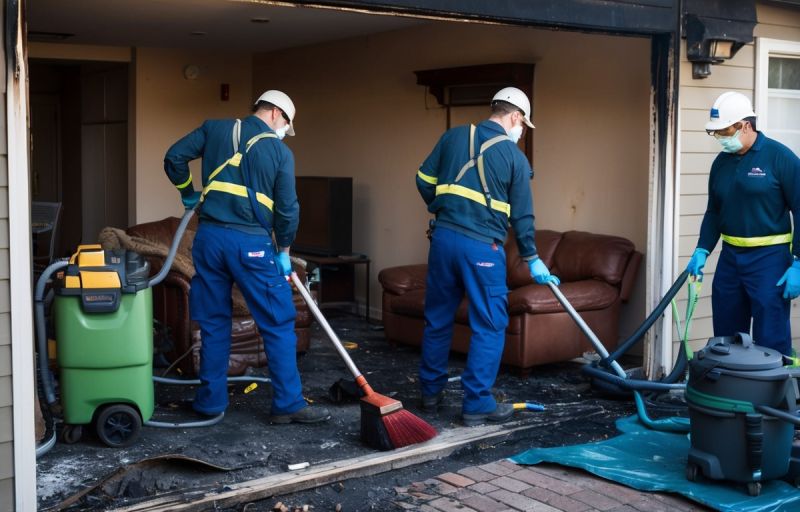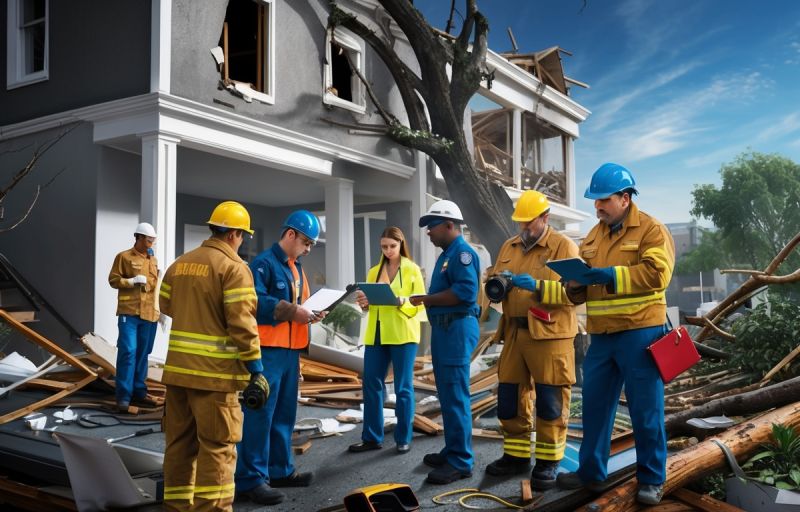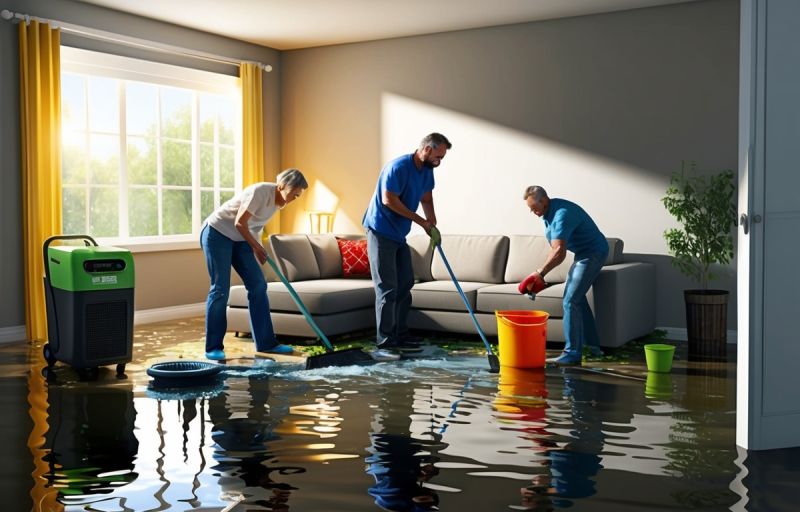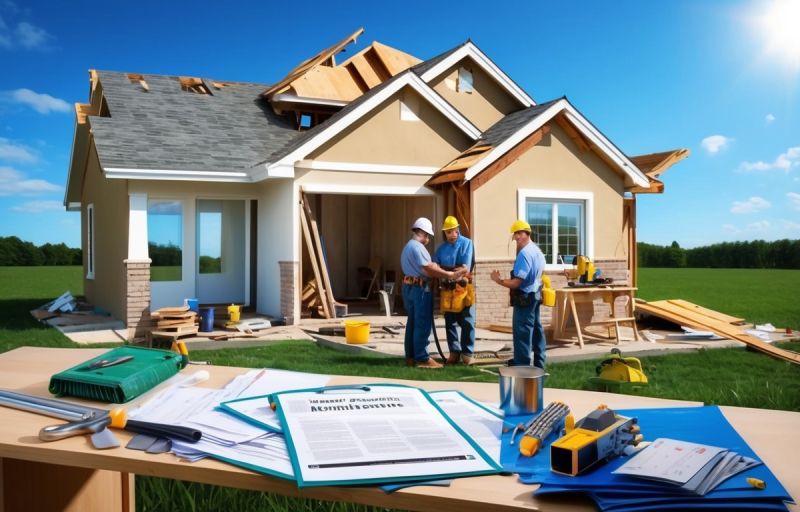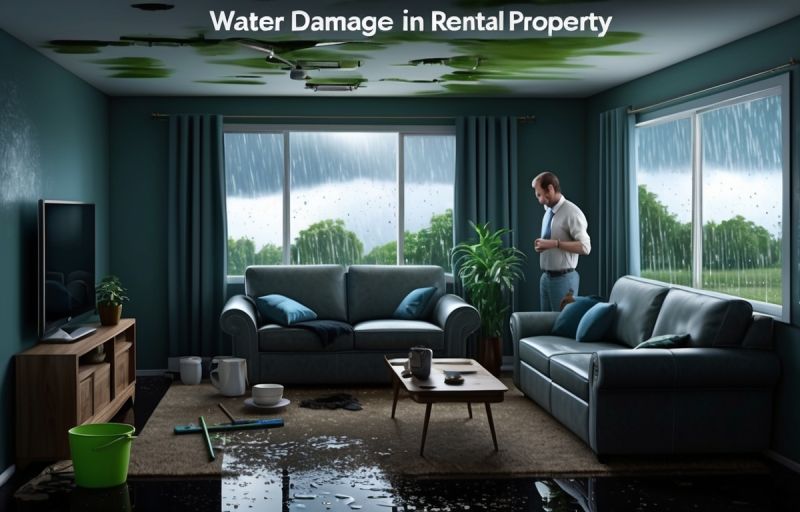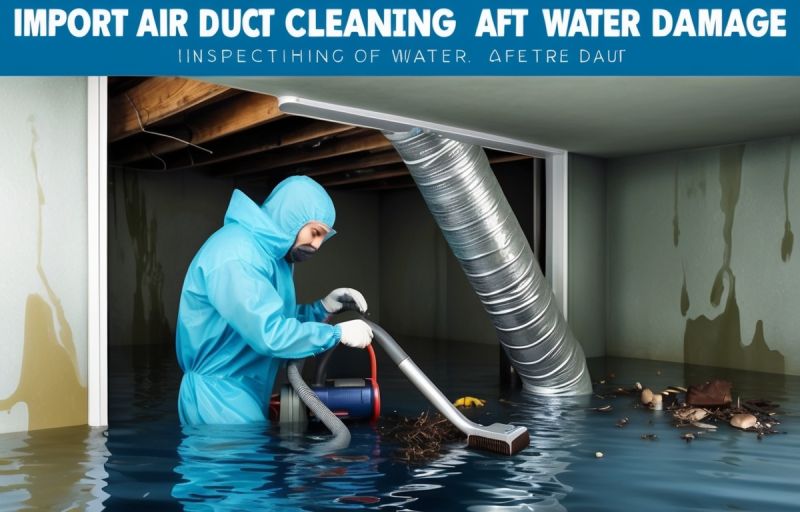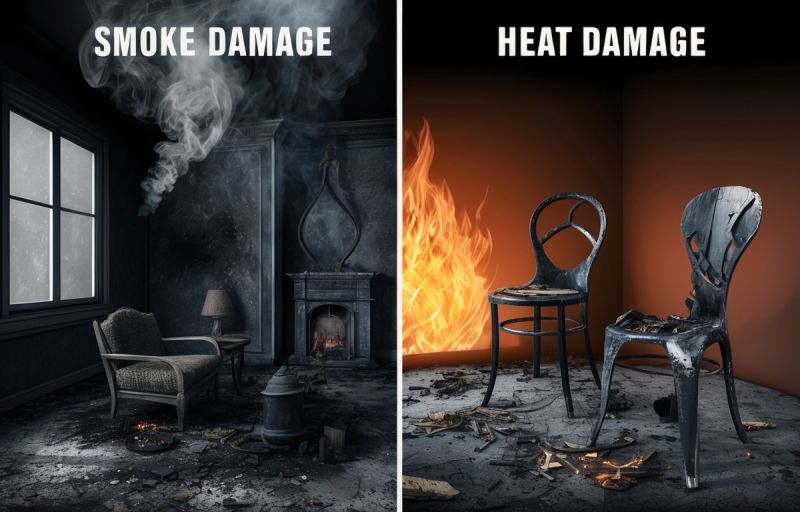When it comes to restoring your property after water or fire damage, choosing the right restoration contractor is crucial. Asking the right questions can help you gauge their expertise and ensure you receive the best service possible. In this guide, we’ll explore essential questions to ask your restoration contractor, focusing on their experience, equipment, and processes. Whether you’re dealing with extensive water damage that requires specialized drying techniques or fire damage that needs immediate attention, understanding the restoration process is key to a successful recovery. At COMMITTED TO QUALITY SERVICE, we pride ourselves on delivering fast, friendly, and professional service. If you’re facing a restoration challenge, don’t hesitate to call us at 855-933-7935. Let’s ensure your property is restored to its former glory with the help of our dedicated team.
What Is Your Experience with Restoration Projects?
When considering restoration projects, it is crucial to evaluate the experience of your restoration contractor. A contractor’s experience can significantly influence the quality and efficiency of the restoration process. Experienced contractors bring a wealth of knowledge and skills that can help navigate the complexities of restoration work, whether it involves water damage, fire damage, or mold remediation.
First and foremost, an experienced contractor will have a proven track record of successfully completed projects. This history not only demonstrates their ability to handle various restoration scenarios but also reflects their commitment to quality and customer satisfaction. For instance, a contractor who has dealt with extensive water damage restoration will understand the nuances of drying techniques, moisture control, and the importance of preventing mold growth. They will be familiar with the latest technologies and methods in the industry, ensuring that they can provide the best solutions for your specific needs.
Moreover, experience often translates to a deeper understanding of local building codes and regulations. Restoration projects must comply with these codes to ensure safety and legality. An experienced contractor will be well-versed in the necessary permits and inspections required for your project, which can save you time and potential legal issues down the line.
Another aspect of experience is the contractor’s ability to manage a team effectively. Restoration projects often require a coordinated effort from various professionals, including plumbers, electricians, and carpenters. An experienced contractor will have established relationships with these tradespeople and will know how to manage their work to ensure that the project runs smoothly and stays on schedule.
Additionally, experienced contractors are typically better at assessing damage and providing accurate estimates. They can identify underlying issues that may not be immediately visible, which is crucial for comprehensive restoration. For example, in cases of water damage, an experienced contractor will know to look for hidden moisture behind walls or under flooring, which can lead to mold growth if not addressed promptly.
It is also important to consider the contractor’s approach to customer service. A contractor with a wealth of experience will understand the stress and disruption that restoration projects can cause for homeowners. They should be able to communicate effectively, providing clear explanations of the process and timelines, and addressing any concerns you may have.
When interviewing potential contractors, consider asking them about their experience with similar projects. Inquire about specific challenges they have faced and how they overcame them. This will give you insight into their problem-solving abilities and adaptability.
Furthermore, you can request references from previous clients. Speaking with past customers can provide valuable information about the contractor’s reliability, quality of work, and overall professionalism.
In summary, the experience of your restoration contractor is a critical factor in the success of your restoration project. Their knowledge, skills, and ability to manage the complexities of restoration work can make a significant difference in the outcome. When selecting a contractor, prioritize those with a solid track record and a commitment to quality service.
For more information on how to choose the right contractor for your restoration needs, you can visit our about page or explore our services to see what we offer. If you are dealing with water damage, check out our guide on water damage for further insights.
Remember, the right contractor can make all the difference in restoring your property to its former glory.
Are You Licensed and Insured?
When hiring a restoration contractor, one of the most critical questions to ask is whether they are licensed and insured. This inquiry is not just a formality; it is a fundamental aspect of ensuring that you are working with a qualified professional who adheres to industry standards and regulations. A valid license indicates that the contractor has met the necessary requirements set by local or state authorities, demonstrating their competence and knowledge in the restoration field. This is particularly important in areas such as water damage, fire damage, and mold remediation, where specialized skills and training are essential for effective and safe restoration.
Insurance is equally important. A reputable restoration contractor should carry both liability insurance and workers compensation insurance. Liability insurance protects you as the homeowner in case of any damage that may occur during the restoration process. For instance, if the contractor accidentally damages your property while working, their insurance will cover the costs, preventing you from incurring unexpected expenses. Workers compensation insurance is crucial as it protects you from liability if a worker is injured on your property while performing their duties. Without this coverage, you could be held responsible for medical expenses and other costs associated with the injury.
Verifying a contractor’s licensing and insurance is a straightforward process. You can request copies of their license and insurance certificates and contact the issuing authorities to confirm their validity. Additionally, reputable contractors will have no issue providing this information upfront. If a contractor hesitates or refuses to provide proof of their licensing and insurance, it is a significant red flag that should not be ignored.
Moreover, hiring a licensed and insured contractor can also provide peace of mind. Knowing that you are working with a professional who is accountable and adheres to industry standards can alleviate some of the stress associated with restoration projects. It ensures that the work will be performed correctly and safely, reducing the likelihood of future issues arising from improper restoration practices.
In conclusion, asking whether a restoration contractor is licensed and insured is a crucial step in the hiring process. It protects you from potential liabilities and ensures that you are working with a qualified professional who can effectively handle your restoration needs. For more information on the services we offer, including water damage and fire damage restoration, visit our services page. If you have any questions or need further assistance, feel free to check our FAQ section or contact us directly.
Can You Provide References from Previous Clients?
When considering a restoration contractor for your property, one of the most critical inquiries you can make is whether they can provide references from previous clients. This question is essential for several reasons. First, references serve as a testament to the contractor’s reliability and quality of work. A reputable contractor should have no hesitation in sharing contact information for past clients who can vouch for their services. Speaking directly with previous clients allows you to gain insights into the contractor’s professionalism, timeliness, and the overall satisfaction of their work. You can ask specific questions about the project, such as how well the contractor communicated throughout the process, whether they adhered to the agreed-upon timeline, and how they handled any unexpected challenges that arose during the restoration.
Additionally, references can provide a glimpse into the contractor’s experience with specific types of restoration work, whether it be water damage, fire damage, or mold remediation. This information is invaluable, as it helps you determine if the contractor has the necessary expertise to handle your unique situation. Furthermore, positive feedback from previous clients can give you peace of mind, knowing that you are entrusting your property to a capable and experienced professional. In contrast, if a contractor is unable or unwilling to provide references, it may raise red flags about their credibility and the quality of their work. Therefore, always prioritize this question when interviewing potential restoration contractors to ensure you make an informed decision for your property restoration needs.
What Is Your Assessment Process for Damage?
When assessing damage, a thorough and systematic approach is crucial for effective restoration. A reputable restoration contractor will typically follow a multi-step assessment process to ensure that all aspects of the damage are identified and addressed. Initially, the contractor will conduct a comprehensive visual inspection of the affected area. This step involves looking for visible signs of damage, such as water stains, charred materials from fire damage, or mold growth. During this inspection, the contractor will also evaluate the surrounding areas to identify any potential hidden damage that may not be immediately visible. Following the visual inspection, the contractor will often use specialized equipment to measure moisture levels in materials and air quality. This is particularly important in cases of water damage, where hidden moisture can lead to mold growth if not addressed promptly. The use of moisture meters and thermal imaging cameras can help pinpoint areas that require further attention. After gathering all necessary information, the contractor will compile a detailed assessment report that outlines the extent of the damage, the materials affected, and the recommended restoration steps. This report is essential for both the homeowner and the insurance company, as it provides a clear understanding of the situation and the necessary actions to restore the property. Additionally, a good contractor will discuss the assessment findings with the homeowner, ensuring that they understand the damage and the proposed restoration plan. This transparency builds trust and helps homeowners make informed decisions about their restoration options. It is also important for the contractor to explain the timeline and costs associated with the restoration process, as this will help homeowners prepare for the upcoming work. Ultimately, a thorough assessment process is vital for effective restoration, ensuring that all damage is identified and addressed properly. For more information on how to identify hidden water damage early, you can visit this link. If you are interested in learning more about our services, please check out this page. Understanding the assessment process can empower homeowners to ask the right questions and ensure they are working with a qualified contractor who prioritizes thoroughness and transparency in their work.
How Will You Communicate Throughout the Project?
Effective communication is a cornerstone of any successful restoration project. When you engage a restoration contractor, it is crucial to establish a clear communication plan that outlines how information will be shared throughout the duration of the project. This ensures that all parties are on the same page, minimizes misunderstandings, and fosters a collaborative environment. Start by discussing the preferred methods of communication. Will updates be provided via email, phone calls, or in-person meetings? Establishing a routine for check-ins can help keep the project on track. For instance, weekly updates can be scheduled to discuss progress, address any concerns, and adjust timelines as necessary. It is also important to identify a primary point of contact on both sides. This person will be responsible for relaying information and making decisions, which streamlines communication and reduces the chances of mixed messages. Additionally, consider using project management tools or apps that allow for real-time updates and documentation sharing. These tools can enhance transparency and provide a centralized location for all project-related information. Another key aspect of communication is setting expectations regarding response times. Discuss how quickly you can expect replies to inquiries and how urgent matters will be handled. This clarity can alleviate frustration and ensure that both you and the contractor are aligned in terms of urgency and priorities. Furthermore, it is beneficial to establish a protocol for addressing issues that may arise during the project. Whether it is a delay in materials, unexpected damage, or changes in scope, having a predefined process for communication can help resolve problems swiftly and efficiently. Lastly, encourage open dialogue throughout the project. Create an environment where questions and feedback are welcomed. This not only helps in addressing concerns promptly but also builds trust between you and your contractor. By prioritizing effective communication, you can enhance the overall experience of your restoration project and ensure that it meets your expectations. For more information on how to choose the right contractor and what to expect during the restoration process, visit our about page or explore our services to understand the range of solutions we offer. If you have specific concerns about water or fire damage, our water damage and fire damage sections provide valuable insights into the restoration process.
What Is the Estimated Timeline for Completion?
When embarking on a restoration project, one of the most crucial aspects to discuss with your contractor is the estimated timeline for completion. Understanding the timeline helps set realistic expectations and allows you to plan accordingly. The duration of a restoration project can vary significantly based on several factors, including the extent of the damage, the type of restoration required, and the availability of materials and labor.
First and foremost, the nature of the damage plays a pivotal role in determining how long the restoration will take. For instance, if you are dealing with water damage, the timeline will depend on the severity of the water intrusion and the areas affected. Minor water damage might only require a few days for drying and repairs, while extensive damage could lead to a timeline stretching several weeks or even months. Similarly, fire damage restoration can be complex, often requiring detailed cleaning, structural repairs, and sometimes even rebuilding parts of the property. Each of these tasks has its own time requirements, which can add up quickly.
Another factor influencing the timeline is the type of restoration services needed. For example, if your home requires mold remediation, the process can take longer due to the need for thorough inspection, containment, and removal of mold-infested materials. Additionally, if your restoration project involves multiple services, such as water damage repair and fire damage restoration, the timeline will need to accommodate the scheduling and coordination of these different tasks.
Communication with your contractor is essential in establishing a realistic timeline. A reputable contractor will conduct a thorough assessment of the damage and provide you with a detailed plan that outlines the steps involved in the restoration process. This plan should include estimated timeframes for each phase of the project, from initial assessment to final inspection. It is also important to discuss potential delays that could arise due to unforeseen circumstances, such as the discovery of hidden damage or delays in obtaining necessary permits or materials.
Moreover, the availability of skilled labor can impact the timeline. In times of high demand, such as after a natural disaster, contractors may have a backlog of projects, which could extend the time it takes to start and complete your restoration. Therefore, it is wise to ask your contractor about their current workload and how it might affect your project timeline.
In addition to these factors, the season and weather conditions can also play a role in the restoration timeline. For example, if your property is located in an area prone to heavy rainfall or snow, weather-related delays could affect the progress of the work. It is beneficial to discuss these considerations with your contractor to gain a clearer understanding of how they might impact your specific project.
Ultimately, having a clear and open line of communication with your restoration contractor is key to understanding the estimated timeline for completion. Regular updates and check-ins can help ensure that you are informed about the progress of the project and any changes to the timeline. By asking the right questions and being proactive in your communication, you can help facilitate a smoother restoration process.
In conclusion, the estimated timeline for completion of a restoration project is influenced by various factors, including the extent of the damage, the type of restoration services required, the availability of materials and labor, and external conditions such as weather. By engaging in thorough discussions with your contractor and understanding the intricacies of the restoration process, you can set realistic expectations and ensure a more efficient and effective restoration experience. For more information on our services and how we can assist you, visit our services page or check out our FAQ section for common questions regarding restoration timelines and processes.
What Are the Costs Involved and What Do They Cover?
When considering restoration services, understanding the costs involved is crucial for homeowners and property managers alike. Restoration projects can arise from various situations, including water damage, fire damage, or mold remediation, and each scenario comes with its own set of expenses. The costs associated with restoration services typically cover several key components, including labor, materials, equipment, and any necessary permits or inspections.
Labor costs are often the most significant portion of the total expense. Skilled technicians are required to assess the damage, develop a restoration plan, and execute the necessary repairs. The complexity of the job, the level of expertise required, and the time involved all contribute to labor costs. For instance, water damage restoration may require specialized training to handle the intricacies of drying out structures and preventing mold growth, while fire damage restoration may involve more extensive repairs and cleaning processes.
Materials and supplies are another critical aspect of restoration costs. Depending on the extent of the damage, contractors may need to purchase new building materials, such as drywall, insulation, flooring, or roofing materials. Additionally, cleaning supplies and specialized equipment, such as dehumidifiers, air scrubbers, and thermal imaging cameras, may also be necessary to ensure a thorough restoration. The quality of materials chosen can significantly impact the overall cost, as higher-quality materials may offer better durability and longevity.
Equipment rental or usage fees can also add to the overall expenses. Restoration projects often require heavy-duty equipment that may not be readily available to homeowners. This includes items like industrial fans, water extraction machines, and other specialized tools. Contractors typically have access to this equipment, but the costs associated with its use will be reflected in the final bill.
Permits and inspections are additional costs that can arise during restoration projects. Depending on local regulations, certain types of restoration work may require permits to ensure compliance with building codes and safety standards. Inspections may also be necessary to assess the extent of the damage and verify that the restoration work meets required standards. These costs can vary widely based on location and the specific nature of the restoration work being performed.
It is also essential to consider the potential for unforeseen costs during a restoration project. Once work begins, contractors may uncover additional damage that was not initially visible. This is particularly common in water damage situations, where hidden moisture can lead to mold growth or structural issues. Homeowners should be prepared for the possibility of additional expenses and discuss how these situations will be handled with their contractor beforehand.
Insurance coverage is another critical factor to consider when evaluating restoration costs. Many homeowners insurance policies cover some or all of the expenses associated with restoration services, particularly in cases of water or fire damage. It is advisable for homeowners to review their insurance policy and consult with their insurance agent to understand what is covered and what deductibles may apply. This knowledge can significantly affect the out-of-pocket costs for restoration services.
When engaging with a restoration contractor, it is vital to ask detailed questions about the costs involved and what those costs cover. A reputable contractor should provide a transparent breakdown of expenses, including labor, materials, equipment, and any additional fees. This transparency helps homeowners make informed decisions and ensures that there are no surprises when the final bill arrives.
In summary, the costs associated with restoration services encompass a variety of elements, including labor, materials, equipment, and permits. Homeowners should be aware of the potential for unforeseen expenses and the importance of insurance coverage. By asking the right questions and seeking clarity on costs, homeowners can better navigate the restoration process and ensure that their property is restored effectively and efficiently. For more information on our services, visit our services page, or if you have specific questions, check out our FAQ section.
Do You Offer a Warranty or Guarantee on Your Work?
When hiring a restoration contractor, one of the most critical questions to ask is whether they offer a warranty or guarantee on their work. A warranty or guarantee serves as a promise from the contractor that the services provided will meet specific standards and that any issues arising from their work will be addressed. This assurance not only reflects the contractor’s confidence in their skills and materials but also provides peace of mind for homeowners and businesses investing in restoration services.
A reputable contractor will typically offer a written warranty that outlines the scope of coverage, duration, and any conditions that may apply. This document is essential as it protects you from potential future costs associated with repairs or issues that may arise after the restoration process is complete. For instance, if you have experienced water damage and the contractor has restored your property, a warranty would ensure that if any related problems occur, such as mold growth or structural issues, the contractor will take responsibility for rectifying them at no additional cost to you.
It is also important to understand the specifics of the warranty being offered. Some warranties may cover only the workmanship, while others might include materials used in the restoration process. Additionally, inquire about the duration of the warranty. A longer warranty period often indicates a contractor’s confidence in their work and the quality of materials used.
Another aspect to consider is whether the warranty is transferable. If you plan to sell your property in the future, a transferable warranty can be a significant selling point, as it assures potential buyers that they will be protected against any issues related to the restoration work.
Moreover, it is advisable to ask about the process for making a claim under the warranty. Understanding how to report an issue and what documentation may be required can save you time and frustration should a problem arise. A contractor who is transparent about their warranty process demonstrates professionalism and a commitment to customer satisfaction.
In addition to warranties, some contractors may offer satisfaction guarantees. This type of guarantee ensures that you will be satisfied with the work performed, and if not, the contractor will make it right. This can provide an additional layer of assurance, especially in restoration projects where the stakes are high, and the potential for emotional distress is significant.
When evaluating a contractor’s warranty or guarantee, it is also wise to research their reputation. Look for reviews and testimonials from previous clients to gauge their experiences regarding the contractor’s reliability and the effectiveness of their warranties. A contractor with a history of honoring their warranties and providing excellent customer service is likely to be a trustworthy choice for your restoration needs.
In conclusion, asking about warranties and guarantees is a crucial step in selecting a restoration contractor. It not only protects your investment but also reflects the contractor’s commitment to quality and customer satisfaction. For more information about our services and how we can assist you with your restoration needs, visit our about page or explore our services. If you have specific concerns about water damage, check out our water damage resources for further insights.
How Do You Handle Unforeseen Issues During Restoration?
Restoration projects can often encounter unforeseen issues that may complicate the process and extend timelines. It is crucial to understand how your restoration contractor plans to handle these unexpected challenges. A reliable contractor should have a clear strategy for addressing unforeseen issues, which can include anything from hidden water damage to structural problems that were not apparent during the initial assessment. When discussing potential complications, ask your contractor about their experience with similar situations and how they have resolved them in the past. This will give you insight into their problem-solving abilities and adaptability.
Additionally, inquire about their communication protocols when issues arise. A good contractor will keep you informed throughout the restoration process, ensuring that you are aware of any changes to the timeline or budget. They should also have a contingency plan in place, which outlines the steps they will take if unexpected problems occur. This plan should include how they will assess the situation, determine the best course of action, and communicate with you about the necessary adjustments.
Furthermore, it is essential to discuss the financial implications of unforeseen issues. Ask your contractor how they handle costs associated with unexpected repairs or complications. A transparent contractor will provide you with a clear understanding of how these costs will be managed and whether they will be covered under the initial contract or require additional funding.
Lastly, ensure that your contractor is licensed and insured, as this will protect you in case of any accidents or further damage during the restoration process. A reputable contractor will have the necessary certifications and will be willing to provide proof of insurance. By asking these essential questions and understanding how your contractor handles unforeseen issues, you can ensure a smoother restoration experience. For more information on the services we offer, visit our services page or learn more about our mission to provide quality restoration solutions.
What Types of Materials and Techniques Do You Use?
When considering a restoration contractor, understanding the types of materials and techniques they utilize is crucial for ensuring a successful restoration project. Different types of damage, whether from water, fire, or mold, require specific approaches and materials to effectively restore your property to its original condition. A reputable contractor will be well-versed in the latest industry standards and practices, employing high-quality materials that are both durable and effective.
For water damage restoration, contractors typically use materials that are resistant to moisture and mold growth. This may include specialized drywall, water-resistant paints, and high-efficiency dehumidifiers. Techniques such as water extraction, drying, and sanitization are essential to prevent further damage and ensure a safe environment. The use of advanced equipment like thermal imaging cameras can help identify hidden moisture pockets, allowing for a thorough restoration process.
In the case of fire damage, restoration contractors often rely on materials that can withstand high temperatures and smoke damage. This includes fire-resistant building materials and specialized cleaning agents designed to remove soot and odors. Techniques such as controlled demolition may be necessary to remove severely damaged structures, followed by rebuilding with fire-rated materials to enhance safety.
Mold remediation requires a different set of materials and techniques. Contractors should use non-toxic, environmentally friendly products that effectively eliminate mold while ensuring the safety of the occupants. Techniques such as containment, air filtration, and thorough cleaning are vital to prevent mold spores from spreading during the remediation process.
It is also important to inquire about the contractor’s commitment to using sustainable materials and practices. Many homeowners are increasingly concerned about the environmental impact of restoration work, and a contractor who prioritizes eco-friendly materials and techniques can help alleviate these concerns.
When discussing materials and techniques, ask your contractor about their sourcing practices. Are they using locally sourced materials? Do they have partnerships with reputable suppliers? Understanding where materials come from can give you insight into their quality and sustainability.
Additionally, consider the contractor’s experience and training in using these materials and techniques. A well-trained team will be familiar with the latest advancements in restoration technology and methods, ensuring that your project is handled with expertise.
In summary, the types of materials and techniques used by your restoration contractor play a significant role in the success of your restoration project. By asking the right questions and understanding their approach, you can ensure that your property is restored effectively and safely. For more information on the services offered, you can visit our services page. If you have specific concerns about water damage, check out our water damage resources for further insights.
Are You Familiar with Local Building Codes and Regulations?
When embarking on a restoration project, whether it involves water damage, fire damage, or mold remediation, understanding local building codes and regulations is crucial. These codes are established to ensure safety, structural integrity, and compliance with legal standards. They vary significantly from one municipality to another, so it is essential to familiarize yourself with the specific requirements in your area. A knowledgeable restoration contractor should be well-versed in these regulations and able to navigate them effectively. This expertise not only helps in avoiding potential legal issues but also ensures that the restoration work meets all necessary safety standards.
Local building codes dictate various aspects of construction and renovation, including materials used, structural modifications, and safety measures. For instance, if your property has suffered from water damage, the contractor must adhere to specific guidelines regarding moisture control and the types of materials that can be used to prevent future issues. Similarly, in the case of fire damage, there are regulations concerning fire-resistant materials and the restoration of electrical systems. Understanding these codes can help you make informed decisions about your restoration project and ensure that the work is completed to a high standard.
Moreover, compliance with local regulations can significantly impact the timeline and cost of your restoration project. If a contractor fails to adhere to these codes, it may result in costly fines, delays, or even the need to redo work that does not meet legal standards. Therefore, it is essential to ask your restoration contractor about their familiarity with local building codes and how they plan to ensure compliance throughout the project. A reputable contractor will be transparent about their knowledge of these regulations and will be able to provide documentation or references to demonstrate their compliance history.
In addition to ensuring compliance, a contractor who is well-versed in local building codes can also help you navigate the permitting process. Many restoration projects require permits, which can be a complex and time-consuming aspect of the restoration process. A knowledgeable contractor will understand the necessary permits for your project and can assist you in obtaining them, saving you time and reducing stress.
Furthermore, understanding local building codes can also enhance the value of your property. When restoration work is completed in accordance with these regulations, it not only ensures safety but also increases the property’s marketability. Potential buyers are often more inclined to purchase a property that has been restored to code, as it indicates that the work was done professionally and safely. Therefore, investing in a contractor who understands local regulations can pay off in the long run.
In conclusion, being familiar with local building codes and regulations is an essential aspect of any restoration project. It ensures safety, compliance, and the overall quality of the work performed. When selecting a restoration contractor, it is vital to inquire about their knowledge of these codes and their approach to ensuring compliance. This will not only help you avoid potential pitfalls but also contribute to the successful completion of your restoration project. For more information on how to choose the right contractor for your needs, visit our about page or explore our services to see how we can assist you with your restoration needs. If you are dealing with specific issues like water damage or fire damage, understanding these regulations becomes even more critical to ensure a successful restoration process.
How Will You Ensure Safety on the Job Site?
Ensuring safety on the job site is a critical aspect of any restoration project. When hiring a restoration contractor, it is essential to ask how they prioritize safety for both their workers and your property. A reputable contractor should have a comprehensive safety plan that adheres to industry standards and regulations. This plan should include proper training for all employees, regular safety meetings, and the use of personal protective equipment. Additionally, the contractor should conduct risk assessments before starting any project to identify potential hazards and implement measures to mitigate them.
Communication is also vital in maintaining a safe work environment. The contractor should establish clear lines of communication among team members and with you, the property owner. This includes informing you about the safety protocols in place and any potential risks associated with the restoration work. Furthermore, the contractor should be transparent about their insurance coverage and liability policies, ensuring that you are protected in case of accidents or damages during the project.
Another important aspect of job site safety is the management of hazardous materials. Restoration projects often involve dealing with substances that can pose health risks, such as mold, asbestos, or chemicals used in the cleaning process. A qualified contractor should have the necessary certifications and training to handle these materials safely. They should also follow proper disposal procedures to minimize environmental impact and ensure compliance with local regulations.
In addition to these measures, a good restoration contractor will have a clear emergency response plan in place. This plan should outline the steps to take in case of an accident or unexpected situation, ensuring that all team members know how to respond quickly and effectively. Regular drills and training sessions can help reinforce this plan and keep safety at the forefront of everyone’s mind.
Finally, it is beneficial to inquire about the contractor’s track record regarding safety. Ask for references or case studies that demonstrate their commitment to maintaining a safe work environment. A contractor with a strong safety history is more likely to prioritize safety on your job site, giving you peace of mind as the project progresses.
By addressing these safety concerns and ensuring that your restoration contractor has a robust safety plan, you can help create a secure environment for everyone involved in the project. For more information on how to choose the right contractor for your restoration needs, visit our about page or explore our services to understand our commitment to safety and quality.
Can You Help with Insurance Claims?
When dealing with the aftermath of property damage, navigating the insurance claims process can often feel overwhelming. One of the essential questions to ask your restoration contractor is whether they can assist you with your insurance claims. A knowledgeable restoration contractor can be an invaluable ally in this process, helping you understand your policy, the extent of your coverage, and the steps necessary to file a successful claim. They can provide detailed documentation of the damage, including photographs and reports that substantiate your claim, which can significantly enhance your chances of receiving a fair settlement from your insurance provider.
Moreover, a reputable contractor will have experience working with various insurance companies and can guide you through the intricacies of the claims process. They can help you identify what is covered under your policy, whether it be water damage, fire damage, or mold remediation, and ensure that all necessary documentation is submitted in a timely manner. This support can alleviate much of the stress associated with filing a claim, allowing you to focus on restoring your property and getting your life back to normal.
Additionally, some restoration contractors may offer direct billing to your insurance company, which can simplify the payment process and reduce your out-of-pocket expenses. It is essential to clarify this aspect with your contractor upfront to understand how they handle insurance claims and what your financial responsibilities will be during the restoration process. By asking the right questions and ensuring that your contractor is equipped to assist with insurance claims, you can navigate this challenging situation more effectively and with greater peace of mind. For more information on how to choose the right contractor and what services they offer, you can visit our services page or check out our about section to learn more about our mission and commitment to helping you through the restoration process.
What Steps Do You Take for Environmental Considerations?
When considering a restoration contractor, it is essential to inquire about their commitment to environmental sustainability. In today’s world, where climate change and environmental degradation are pressing issues, choosing a contractor who prioritizes eco-friendly practices can make a significant difference. A responsible restoration contractor should take several steps to minimize their environmental impact while effectively addressing your restoration needs. First and foremost, they should utilize environmentally friendly materials and products. This includes using low-VOC (volatile organic compounds) paints, sealants, and cleaning agents that reduce harmful emissions and improve indoor air quality. Additionally, they should prioritize sustainable sourcing of materials, opting for recycled or reclaimed products whenever possible. This not only reduces waste but also conserves natural resources. Furthermore, a reputable contractor should implement waste management strategies that focus on recycling and proper disposal of materials. This includes separating recyclable materials from general waste and ensuring that hazardous materials are disposed of according to local regulations. Another critical aspect is energy efficiency. A contractor should be knowledgeable about energy-efficient solutions, such as installing energy-efficient appliances, insulation, and windows, which can significantly reduce energy consumption in the long run. Moreover, they should be equipped to handle water damage with a focus on conservation. This means using advanced techniques to minimize water waste during the restoration process and ensuring that any water used is treated responsibly. It is also vital for the contractor to have a clear plan for dealing with mold remediation, as mold can pose health risks and contribute to environmental issues. They should follow best practices for mold removal that prioritize safety and environmental health. Lastly, a commitment to ongoing training and education about sustainable practices is crucial. A contractor that invests in their team’s knowledge about the latest eco-friendly technologies and methods demonstrates a genuine commitment to environmental considerations. By asking these questions and evaluating the contractor’s responses, you can ensure that your restoration project not only meets your needs but also aligns with your values regarding environmental stewardship. For more information on how to choose the right contractor, visit our about page or explore our services to see how we prioritize sustainability in our restoration efforts.
FAQ: Essential Questions to Ask Your Restoration Contractor
Q1: Why is it important to ask questions before hiring a restoration contractor?
A1: Asking questions helps you assess the contractor’s qualifications, experience, and reliability. It ensures that you choose a professional who understands your needs and can provide quality service, ultimately protecting your property and investment.
Q2: What qualifications should I look for in a restoration contractor?
A2: Look for contractors who are licensed, insured, and certified in restoration services. Certifications from organizations like the Institute of Inspection, Cleaning and Restoration Certification (IICRC) indicate that they have met industry standards.
Q3: What experience should a restoration contractor have?
A3: Ideally, a contractor should have several years of experience in restoration work, particularly with the type of damage you are facing (e.g., water, fire, mold). Ask for examples of similar projects they have completed successfully.
Q4: How do I know if a restoration contractor is reputable?
A4: Research the contractor’s reputation by checking online reviews, testimonials, and ratings on platforms like the Better Business Bureau (BBB). You can also ask for references from previous clients to gauge their satisfaction.
Q5: What specific questions should I ask a restoration contractor?
A5: Here are some essential questions to consider:
- What is your process for assessing damage and creating a restoration plan?
- How long do you expect the restoration process to take?
- What types of equipment and techniques do you use?
- Will you provide a detailed written estimate?
- How do you handle insurance claims and paperwork?
- What is your warranty or guarantee on the work performed?
Q6: How can I ensure that the restoration contractor communicates effectively?
A6: Ask about their communication practices. A good contractor should be responsive, provide regular updates, and be available to answer your questions throughout the restoration process.
Q7: What should I expect in terms of cost for restoration services?
A7: Costs can vary widely based on the extent of the damage, the type of restoration needed, and the contractor’s pricing structure. Request detailed estimates from multiple contractors to compare prices and services.
Q8: How do restoration contractors handle emergencies?
A8: Inquire if the contractor offers emergency services and how quickly they can respond. A reliable contractor should be available 24/7 for urgent situations to prevent further damage.
Q9: What safety measures do restoration contractors take?
A9: Ask about the safety protocols they follow, especially when dealing with hazardous materials like mold or asbestos. A professional contractor should prioritize safety for both their team and your property.
Q10: What happens if I am not satisfied with the restoration work?
A10: Discuss the contractor’s policy on addressing dissatisfaction. A reputable contractor should have a clear process for handling complaints and ensuring customer satisfaction.
By asking these essential questions, you can make an informed decision when selecting a restoration contractor, ensuring that your property is in capable hands.


